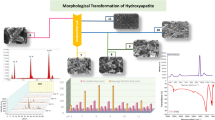Abstract
Hydroxyapatite (HAp) [Ca10(PO4)6(OH)2] nanorods were synthesized using a surfactant templating method, with cetyltrimethylammonium bromide (CTAB) micelles acting as template for HAp growth. The effects of the sintering temperature on the morphological and crystallographic characteristics and on chemical composition of the “as-prepared” structures are discussed. The experimental results show that low heat-treatment temperatures are preferred in order to obtain high quality nanorods, with diameters ranging between 20 and 50 nm. High heat-treatment temperatures enhance the thermal decomposition of HAp into other calcium phosphate compounds, and the sintering of particles into micrometer ball-like structures. The stability of aqueous suspensions of HAp nanorods is also discussed.






Similar content being viewed by others
References
Rao CNR, Cheetham AK. Materials science at the nanoscale. In: Gogotsi Y, editor. Nanomaterials handbook. New York: CRC Press, Taylor & Francis Group; 2006. p. 1–2.
Guo Y, Shi D, Lian J, Wang ZDW, Cho H, Liu G, et al. Quantum dot conjugated hydroxylapatite nanoparticles for in vivo imaging. Nanotechnology 2008;19:175102 (6 pp).
Queiroz AC, Teixeira S, Santos JD, Monteiro FJ. Production of porous hydroxyapatite with potential for controlled drug delivery. Mater Sci Forum. 2004;455–456:358–60.
Vallet-Regí M. Ceramics for medical applications. J Chem Soc Dalton Trans. 2001;2:97–108.
Dorozhkin SV, Epple M. Biological and medical significance of calcium phosphates. Angew Chem Int. 2002;41:3130–46.
Ferraz MP, Monteiro FJ, Manuel CM. Hydroxyapatite nanoparticles: a review of preparation methodologies. J Appl Biomater Biomech. 2004;2:74–80.
Cengiz B, Gokce Y, Yildiz N, Aktas Z, Calimi A. Synthesis and characterization of hydroxyapatite nanoparticles. Colloids Surf A Physichochem Eng Aspects. 2008;322:29–33.
Ying JY, Mehnert PC, Wong MS. Synthesis and application of supramolecular-templated mesoporous materials. Angew Chem Int Ed. 1999;38:56–77.
Cates ME, Fielding SM. Rheology of giant micelles. Adv Phys. 2006;55:799–879.
Nagarajan R. Molecular thermodynamics of giant micelles. In: Zana R, Kaler EW, editors. Giant micelles—properties and applications. New York: CRC Pess, Taylor & Francis Group; 2007. p. 2–5.
Li Y, Tjandra W, Tam KC. Synthesis of nanoporous hydroxyapatite using cationic surfactants as templates. Mater Res Bull. 2008;43:2318–26.
Yao J, Tjandra W, Chen YZ, Tam KC, Mab J, Soh B. Hydroxyapatite nanostructure material derived using cationic surfactant as a template. J Mater Chem. 2003;13:3053–7.
Berret JF. Rheology of wormlike micelles: equilibrium properties and shear banding transition. In: Weiss RG, Terech P, editors. Molecular gels. Materials with self-assembled fibrillar networks. Dordrecht: Springer; 2006. p. 667–720.
Kresge CT, Leonowicz ME, Roth WJ, Vartuli JC, Beck JS. Ordered mesoporous molecular sieves synthesized by a liquid-crystal template mechanism. Nature. 1992;359:710–2.
Beck JS, Vartuli JC, Roth WJ, Leonowicz ME, Kresge CT, Schmitt KD, et al. A new family of mesoporous molecular sieves prepared with liquid crystal templates. J Am Chem Soc. 1992;114:10834–43.
Li YY, Li J, Nakajima B. Nanostructured porous biomaterials for controlled drug release systems. In: Paul KC, Xuanyong L, editors. Biomaterials-fabrication and processing. New York: CRC Press, Taylor & Francis Group; 2008. p. 196–206.
Herzberg G. The infrared and Raman spectra of poliatomic molecules. New York: D van Nostrand Company, Inc.; 1945.
Awonusi A, Morris MD, Tecklenburg MMJ. Carbonate assignment and calibration in the Raman spectrum of apatite. Calcif Tissue Int. 2007;81:46–52.
Fowler BO. Infrared studies of apatites. I. Vibrational assignments for calcium, strontium, and barium hydroxyapatites utilizing isotopic substitution. Inorg Chem. 1974;13:194–207.
Aza PN, Santos C, Pazo A, Aza S, Cuscó R, Artus L. Vibrational properties of calcium phospate coumpounds. 1. Raman spectrum of β-tricalcium phosphate. Chem Mater. 1997;9:912–5.
Author information
Authors and Affiliations
Corresponding author
Rights and permissions
About this article
Cite this article
Coelho, J.M., Moreira, J.A., Almeida, A. et al. Synthesis and characterization of HAp nanorods from a cationic surfactant template method. J Mater Sci: Mater Med 21, 2543–2549 (2010). https://doi.org/10.1007/s10856-010-4122-5
Received:
Accepted:
Published:
Issue Date:
DOI: https://doi.org/10.1007/s10856-010-4122-5




